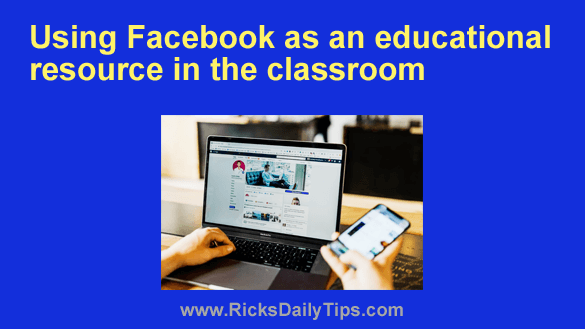 Social media has proven itself useful in aiding students’ learning and development. Even so, not many schools and other educational institutions use platforms like Facebook for education.
Social media has proven itself useful in aiding students’ learning and development. Even so, not many schools and other educational institutions use platforms like Facebook for education.
The numbers are growing as the educational system is grasping technology, but we are still a long way from a study environment where social media is used as a learning tool.
In most cases, students use Facebook classroom tools for finding data only, or they are not allowed to use this platform altogether.
Reality is, if the students get proper guidance and access to useful resources, Facebook can be an amazing platform that makes their work more engaging, gives them more access to information, and enriches the learning process.
In this article, you’ll learn exactly that – why and how to use Facebook as an educational resource in a classroom.
What You Get When You Use Facebook in the Classroom
Let’s first go through the advantages of using Facebook in the classroom:
Access to Useful Information
With so many people using social channels these days, there’s hardly anything you cannot find on Facebook. Students can use it to find books to buy or rent, join groups with other students, as well as receive announcements about useful things like homeworks from EduBirdie. Edubirdie, a trending writing platform frequently posts announcements about homework samples that can help the students in developing their writing skills.
On top of that, students can reach out to EduBirdie and say: ‘do my homework’. Homework writing serves to help the student learn better, but sometimes the students decide to pay for help because they lack the time or skills to get things done. Social media is one great way to reach out to the right source of help.
Finally, students can access educational news Facebook and learn about new tasks, changes in schedules, as well as access new materials to learn from.
Promoting Collaboration and Creating a Strong Community
The influence of social media on students’ performance is grand for a variety of reasons, and access to information and ease of communication are the top 2 in the list.
Facebook is originally designed for networking, which is why it is known to be a highly effective way to connect. Many students in high-level education struggle with constraints such as lack of time due to children and work, long commutes, etc. Not to mention, many study online these days, and platforms like Facebook are facilitating communication with their peers and professors.
A survey by Roblyer shows that students use Facebook to communicate as often as they use email, but instructors today rely mostly on email to talk to their students. Because of the ease of use and the grand number of people that use it, Facebook is an amazing option for communicating with a class, and it can greatly promote collaboration and create a stronger community.
Some Useful Tips on How to Get in Facebook in School
Chances are, each and every one of your students owns a phone and has Facebook installed on it. This makes it very easy to use Facebook in the classroom, as well as the many benefits it offers. Let’s go through some ideas on how to use Facebook in the classroom.
Facebook for Educational Resources
Resources on this platform include more than just status updates. Students and teachers can use it to:
- Ask other Facebook users for information
- Implement surveys to Facebook users
- Connect with public figures or experts in the field they are studying
- Attend remote lectures from home
- Follow experts in the field
- Play learning games for entertainment
Facebook for Projects and Assignments
Facebook is a great platform to learn on. Here are some ideas for it:
- Read and share book reviews
- Follow media outlets and journalists to collect data
- Access video lessons on social media
- Create a scavenger hunt with clues and hints for the young students
- Host regular book clubs
- Post educational content
- Practice for exams on Facebook
Facebook for Discussion and Collaboration
Everyone can join in the conversation on Facebook in different or the same group. This includes students, teachers and parents. Here are some ideas for it:
- Groups for class communication
- Teacher-parent groups to share information and ask questions
- Writing workshops
- Discussing work
- Groups of new and old students in the school
- Classroom polls for decisions that the group makes
Conclusion
There you have it – a list of ideas on how you can use Facebook as an educational aid in the classroom. There’s no harm in having some fun and using modern technology to learn. As a matter of fact, this has shown tremendous results in terms of students’ participation and productivity!